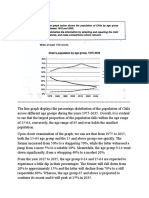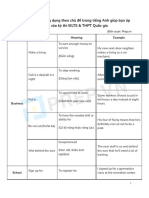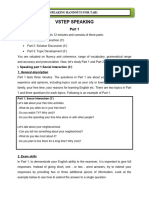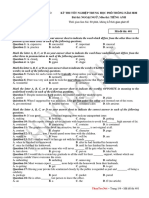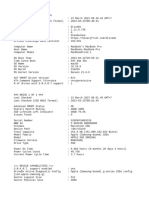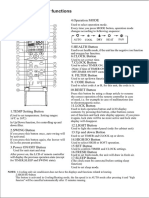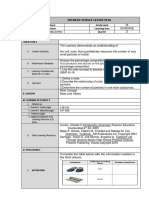Different Chart
The graph and chart give information and forecast about the vehicle and CO2 emission in
England and Wales between 2000 and 2020
� Answer
Task 1 plan:
Paraphrase task heading
Summary paragraph – 2 key features:
o [1] bar chart: increasing C02 emissions – cars, vans and trucks
o [2] line graph: increase in the number of road vehicles
Paragraph 3: bar chart details: compare C02 emissions in 2000 from cars, vans and
trucks. Contrast with low figure for buses. Compare predicted 2020 emissions from
cars, vans and trucks. Contrast again with low figure for buses.
Paragraph 4: give number of road vehicles in 2000 and note trend 2000 - 2015. Give
2015 figure. Give projected figure for 2020.
The bar chart compares the amount of CO2 emissions produced by four types of vehicles. The
line graph shows the number of vehicles. Both diagrams refer to England and Wales for the
period 2000 to 2020.
Overall, the chart indicates a rise in the emission of CO2 from cars, vans and trucks between
these years. The graph shows that the number of vehicles on the road is expected to continue
to increase sharply.
In 2000, CO2 emissions from cars was the highest figure at 20 tons. The emissions from trucks
and vans was similar, at 15 and 13 tons respectively, whereas the emissions from buses totalled
just 9 tons. By 2020, a rise in car emissions to over 25 tons of CO2 is forecast, with a smaller
rise in emissions from trucks and vans. It is predicted that trucks will produce about 23 tons
and vans will emit 15 tons. In contrast, the figure for CO2 emissions from buses will continue
to be the lowest amount, remaining stable at 9 tons.
The number of road vehicles was 20 million in 2000. This increased rapidly to 50 million by
2015 and is expected to increase to 55 million by 2020.
199 words
�Different Charts
The diagrams below give information on transport and car use in Edmonton.
Summarise the information by selecting and reporting the main features, and
make comparisons where relevant.
� Answer
Task 1 plan:
Paraphrase task heading: one sentence for the pie chart and one sentence for the table.
Summary paragraph – key features
o [1] pie chart: travel by car is the highest percentage
o [2] table: people use their cars to commute to work more than for any other
reason.
Compare proportions shown in pie chart.
Compare reasons why people use their cars.
The pie chart shows four modes of transport in Edmonton and the percentage use of each by
people living in the city. The table illustrates the reasons why the residents of Edmonton use
their cars.
Overall, cars are used in preference to other means of transport. The principal reason why
people use their cars in the city is commuting to work.
It is clear from the percentages shown in the pie chart, that travel by car is the highest figure,
at 45%. This is followed by LRT at 35%, while travel by bus or taxi each represent only 10%.
The table compares five reasons why people use their cars in Edmonton. The reasons given
relate mainly to work, with a figure of 55% for commuting and 45% for business. However,
taking children to school is also high on the list, at 40%. Using the car for shopping is recorded
at 15% and the same figure is given for leisure activities.
160 words.
�Different Charts
The bar chart below shows the estimated sales of jeans for two companies next year in
Turkey. The pie chart shows the projected market share of the two companies in jeans at
the end of next year.
Write a short report for a university lecturer describing the information
shown below.
� Answer
Task 1 plan:
Paraphrase task heading, using some different words.
Summary paragraph – key features [1] sales will increase [2] Mango and Jack&Jones
will be the two market leaders
Describe trend for Mango sales – January; July/August and December. Compare trend
for Jack&Jones sales – January/February; June-August and
December
Describe what pie chart shows
The bar chart compares the estimated sales of jeans in thousands of pairs for two companies
in Turkey next year. The pie chart illustrates the projected total market share.
The overall sales for both companies are forecast to grow. They are expected to be the market
leaders for sales of jeans at the end of the coming year.
It is anticipated that sales of jeans by Mango will rise from 150,000 pairs in January to
approximately 500,000 in August, even overtaking the sales of Jack and Jones in July and
August. Sales will then peak at around 600,000 pairs in December. In contrast, it is estimated
that the sales for Jack & Jones will begin the year at around 450,000 pairs, falling to about
250,000, before increasing to around 400,000 in June. Until August, sales are forecast to
remain steady at this level, after which they are expected to rise steadily to hit a peak of
approximately 900,000 pairs in December.
The pie chart shows that, at the end of next year, the anticipated market share for
Mango and Jack & Jones is 20% and 30% respectively.
(187 words)
�Different Charts
The two figures below show the rate of criminal convictions among men and women of different
ages in the UK and the proportion of male and female prison inmates in the British prison
system.
Summarise the information by selecting and reporting the main features, and make comparisons
where relevant
� Answer
Given are two figure concerning criminality in Britain. The first provides data on the rates of
conviction among men and women of various ages, while the second indicates the gender
balance of the UK prison population.
It is apparent from the information supplied that the rate of conviction among Brits of both
sexes increases exponentially during adolescence and peaks at the age of about 20. Also
evident is the fact that men are far more likely to offend than women. From a negligible 2
percent among 10-year-old boys, the male conviction rate soars to approximately 16 percent
among 20-year-olds. The percentage of female offenders, meanwhile, climbs from 0 percent
among girls of 10 to some 5 percent for 20-year-olds. The subsequent decades, however, see
dramatic decreases in criminality among both sexes. A mere 2 percent of crimes are committed
by 60-year-old men and 0 percent by women of the same age.
As for the proportion of male and female prison inmates, men outnumber women 24 to 1.
Some 96 percent of all prisoners are men, while the remainder are female.
(180 words)
�Different Charts
The figures below compare the number of internet users in several European nations as well as the
prevalence of online shopping in these countries.
Summarise the information by selecting and reporting the main features, and make comparisons where
relevant.
� Answer
Given are two figures providing a comparison of internet use in five European countries
(namely Switzerland, Germany, France, Spain and the UK) in 1995, 2000 and 2004, as well
as the popularity of internet shopping in these countries.
It is evident from the information provided that Britain had by far the highest number of
internet users in all three years. From 16 million in 1995, the number of British user climbed
steadily to 22 million in 2000, before soaring to a staggering 41 million in 2004. Second in
terms of internet use was Germany. This country saw a threefold increase during the period in
question, from 15 million people in 1995 to 14 million in 2000 and 15 million in 2004. A
similar increase took place in France. The two nations with the fewest internet users,
meanwhile, were Switzerland and Spain.
It is also interesting to note that internet shopping was far more common in the UK than in any
other country listed. In fact, the prevalence of internet shopping in Britain was double that of
Germany and triple that of Switzerland. France and Spain, meanwhile, had moderate levels of
online shopping.
(192 words)
�Different Charts
The graph and table below give information about water use worldwide and water consumption
in two different countries.
Summarise the information by selecting and reporting the main features, and make comparisons
where relevant.
� Answer
The charts compare the amount of water used for agriculture, industry and homes around the
world, and water use in Brazil and the Democratic Republic of Congo.
It is clear that global water needs rose significantly between 1900 and 2000, and that
agriculture accounted for the largest proportion of water used. We can also see that water
consumption was considerably higher in Brazil than in the Congo.
In 1900, around 500km³ of water was used by the agriculture sector worldwide. The figures
for industrial and domestic water consumption stood at around one fifth of that amount. By
2000, global water use for agriculture had increased to around 3000km³, industrial water use
had risen to just under half that amount, and domestic consumption had reached approximately
500km³.
In the year 2000, the populations of Brazil and the Congo were 176 million and 5.2 million
respectively. Water consumption per person in Brazil, at 359m³, was much higher than that in
the Congo, at only 8m³, and this could be explained by the fact that Brazil had 265 times more
irrigated land.
�Different Charts
The pie chart below shows the main reason why agricultural land becomes less productive. The
table shows how these causes affected three regions of the word during the 1990s
Summarise the information by selecting and reporting the main features and make comparisons
where relevant
� Answer
The pie chart shows that there are four main causes of farmland becoming degraded in the
world today. Globally, 65% of degradation is caused by too much animal grazing and tree
clearance, constituting 35% and 30% respectively. A further 28% of global degradation is due
to over-cultivation of crops. Other causes account for only 7% collectively.
These causes affected different regions differently in the 1990s, with Europe having as much
as 9.8% of degradation due to deforestation, while the impact of this on Oceania and North
America was minimal, with only 1.7% and 0.2% of land affected respectively. Europe, with
the highest overall percentage of land degraded (23%), also suffered from over-cultivation
(7.7%) and over-grazing (5.5%). In contrast, Oceania had 13% of degraded farmland and this
was mainly due to over-grazing (11.3%). North America had a lower proportion of degraded
land at only 5%, and the main causes of this were over-cultivation (3.3%) and, to a lesser
extent, over-grazing (1.5%)
Overall, it is clear that Europe suffered more from farmland degradation than the other regions,
and the main causes there were deforestation and over-cultivation.
�Different Charts
The graph and table below give information about water use worldwide and water consumption
in two different countries.
Summarise the information by selecting and reporting the main features and make comparisons
where relevant.
� Answer
The graph shows how the amount of water used worldwide changed between 1900 and 2000.
Throughout the century, the largest quantity of water was used for agricultural purposes, and
this increased dramatically from about 500 km3 to around 3,000 km3 in the year 2000. Water
used in the industrial and domestic sectors also increased, but consumption was minimal until
mid-century. From 1950 onwards, industrial use grew steadily to just over 1,000 km 3, while
domestic use rose more slowly to only 300 km3, both far below the levels of consumption by
agriculture.
The table illustrates the differences in agricultural consumption in some areas of the world by
contrasting the amount of irrigated land in Brazil (26,500 km2) with that in the D.R.C (100
km2). This means that a huge amount of water was used in agriculture in Brazil, and this is
reflected in the figures for water consumption per person: 359 m3 compared with only 8 m3 in
Congo. With a population of 176 million, the figures for Brazil indicate how high agricultural
water consumption can be in some countries.
�Different Charts
The pie charts below show the market share over a decade, of a new washing machine introduced
by Dyton in 1990. The bar chart shows the results of a survey on whether customers would
consider buying the new Dyton washing machine over the same period.
� Answer
The pie charts show the market share of washing machines made by four companies over the
period 1990 to 2000 and the results of a survey on whether customers would consider buying
the new Dyton washing machine over the same period.
During the first year of sales of the new Dyton machine in 1990, its market share stood at 2
percent as opposed to 60 percent for the MMC product, 20 for the Corr washing machine and
18 for that of Obecalp. In 1995, however, MMC Ltd lost ground to its three other competitors.
While Corr Ltd and Obecalp Ltd both increased their market share to by one percentage point
each in 1995, Dyton Ltd captured 8% of the market, a rise of 300%.
In 2000, Dyton’s market share had increased to 32% at the expense of its three main
competitors with MMC Ltd, Obecalp Ltd and Corr Ltd falling to 39 percent, 17 percent and
12 percent respectively.
The bar chart shows that the Dyton machine exceeded its popularity rating in each year, rising
from 5 in 1995 to 40 percent in the year 2000.
It is clear that the sales of the Dyton washing machine were on the increase over the period.











